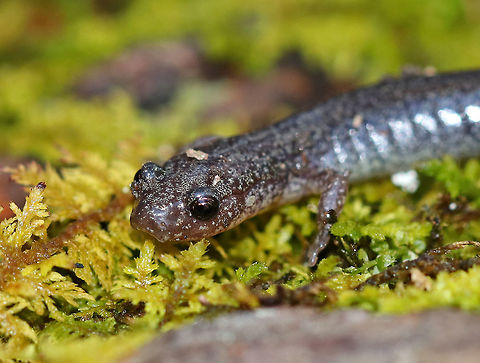
Appearance
The red-backed salamander is a small terrestrial salamander, 5.7–10.0 cm in total length, which usually lives in forested areas under rocks, logs, bark, and other debris. It is one of the most numerous salamanders throughout its range.The red-backed salamander exhibits color polymorphism and two color variations are common: the "red-backed" or "red-stripe" variety has a red dorsal stripe that tapers towards the tail, and the darker variety, known as the "lead-backed" phase, lacks most or all of the red pigmentation. The red-backed phase is not always red, but may actually be various other colors. Both morphs have speckled black and white bellies.
The skin of red-backed salamanders was found to contain "Lysobacter gummosus", an epibiotic bacterium that produces the chemical 2,4-diacetylphloroglucinol and inhibits the growth of certain pathogenic fungi.
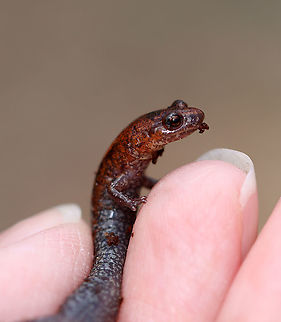
Naming
It is also known as the redback salamander, eastern red-backed salamander, or the northern red-backed salamander to distinguish it from the southern red-backed salamander.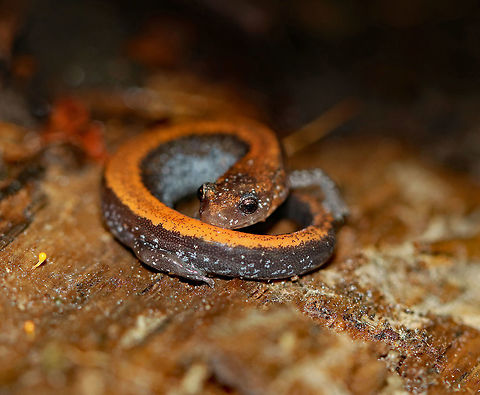
Behavior
Antipredator behavior of "P. cinereus" was found to differ between the two color phases; the lead-backed phase has a tendency to run away from predators, whereas the red-backed phase often stays immobile and possibly exhibits aposematic coloration. Stress levels of each color phase were estimated by determining the ratio of neutrophil to lymphocyte cells in the blood, and the results suggest stress levels are higher in the lead-backed phase than in the red-backed phase. This may be a consequence of a higher predation risk experienced in the wild by the lead-backed phase, and may also mean lead-phase salamanders could be more vulnerable in captivity settings.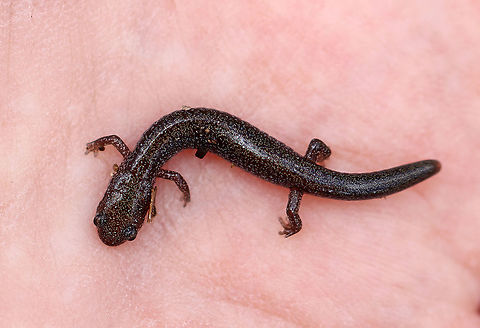
Habitat
The red-backed salamander is a small terrestrial salamander, 5.7–10.0 cm in total length, which usually lives in forested areas under rocks, logs, bark, and other debris. It is one of the most numerous salamanders throughout its range. The red-backed salamander exhibits color polymorphism and two color variations are common: the "red-backed" or "red-stripe" variety has a red dorsal stripe that tapers towards the tail, and the darker variety, known as the "lead-backed" phase, lacks most or all of the red pigmentation. The red-backed phase is not always red, but may actually be various other colors. Both morphs have speckled black and white bellies.The skin of red-backed salamanders was found to contain "Lysobacter gummosus", an epibiotic bacterium that produces the chemical 2,4-diacetylphloroglucinol and inhibits the growth of certain pathogenic fungi.
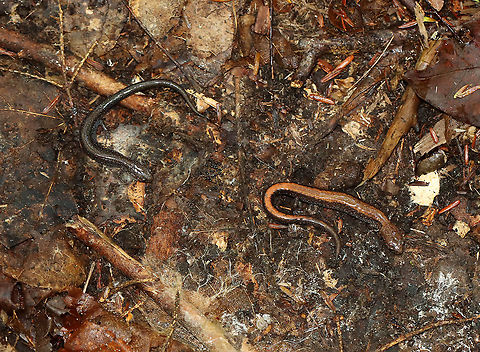
Reproduction
Males and females of "P. cinereus" typically establish separate feeding and/or mating territories underneath rocks and logs. However, some red-backed salamanders are thought to engage in social monogamy, and may maintain codefended territories throughout their active periods. Breeding occurs in June and July. Females produce from four to 17 eggs in a year. The eggs hatch in 6 to 8 weeks. Not much is known about the dispersal of neonates, although neonates and juveniles are thought to be philopatric. The species largely consumes invertebrates and other detritus dwellers. In some areas with good habitat, these salamanders are so numerous, their population densities may surpass 1,000 individuals per acre. Pokagon State Park in Indiana is one such place.References:
Some text fragments are auto parsed from Wikipedia.